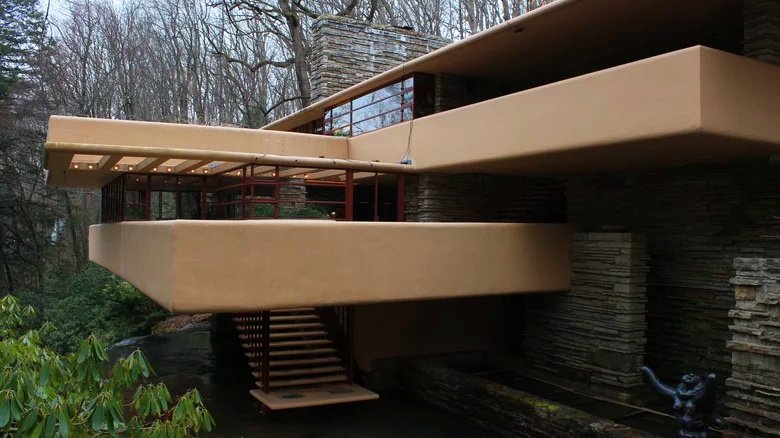By Lin Walker and Mike Pulcinella
This past weekend we had the privilege of attending a fundraising Soiree at Frank Lloyd Wright’s Fallingwater, the iconic vacation home built on a waterfall.
In the early 1930s the department store magnate Philip Kaufmann asked the very famous modern architect, Frank Lloyd Wright, to build his family a permanent vacation residence in the woods just outside of Pittsburgh, Pennsylvania.
Wright, who was already famous for turning his back on the compartmentalized architectural style of the Victorian era, was one of the first innovators of what would become the open plan Mid-Century Modern home that we are familiar with today. Recognized as an innovator and rule-breaker, Wright built the Kaufmann’s vacation home on top of a waterfall to coexist with the flow of the water, rather than build at the base of the waterfall where the natural feature would be visible to the inhabitants of the structure.
The house, with its daring cantilevered balconies jutting out over the rushing water (technologically innovative for the time) is sculpturally stunning. Once inside Fallingwater, you cannot see the waterfall, but you can hear it. Wright wanted the inhabitants of this modern structure to live with the waterfall rather than treat it as a pretty postcard view.
But it is the intimate nooks and crannies everywhere throughout the structure that reveal the genius of Wright. There are so many spaces, inside and out, cozy or expansive, that invite rest and contemplation. No matter whether you are inside Fallingwater, or enjoying one of its many balconies, there is a unique feeling of harmony between the structure and the environment.
Inside Fallingwater
Architecture in general is something that is close to our hearts and is a great topic for a deeper dive into O-1s, something equally near and dear to us. And architecture is one of those rare professions that is both art and science and therefore gives us the flexibility to decide what kind of O-1 Visa best suits the petitioner.
More than any other structure we’ve seen, Fallingwater embodies the practical blended with the fanciful, the functional joined with the spiritual in a way that really brings home the notion that architecture is a unique discipline that can cross over the lines of categorization when petitioning for an O-1 Visa.
Interesting details are everywhere
Because architecture embodies both art and science, that gives us the flexibility to decide whether the architect has a better chance of getting an O-1A or an O-1B petition approved. In other words, applying as a kind of engineer or scientist, in the case of the O-1A. Or would it be better to petition as an O-1B, wherein the architect is presented as an artist? For this profession, we have a choice.
Sydney Opera House - Architecture as art
Architecture as Art
To make the argument that architecture is art one can begin by emphasizing the beautiful, graceful, aesthetic and sculptural aspects of the structure. We can also talk about the “feel” or the “soul” of a place, which some would define as the “spiritual” component of a structure.
Generally speaking architecture, as opposed to engineering, is rooted more firmly in the world of artistic expression, requiring a variety of artistic expertise in addition to considerable technical building skill.
The visual, sculptural aspects of the design of buildings are easy to appreciate. The spiritual might not be as easy to define, but often when speaking of the “feeling” of a space people use words like serenity, energy, peacefulness, atmosphere and mood.
An architect who is able to evoke these emotions with their buildings is certainly operating in the world of art.
The design of this chapel is clearly intended to evoke a feeling
Very often an architect will push the artistic aspect of a structure even further and prioritize the aesthetic over the functional, creating seemingly impractical design details meant to evoke awe, wonder or contemplation, much like the flying cantilever balconies of Fallingwater or the more contemporary metallic curvilinear surfaces of the Walt Disney Concert Hall by Frank Gehry.
Cantilever balconies of Fallingwater - a technical challenge in the 1930s
Walt Disney Concert Hall - Designed by Frank Gehry
Some of the best examples of architects emphasizing the artistic over the functional to evoke a contemplative or reverent mood can be seen in designs of places of worship. With these structures the artistic and sculptural elements of designed spaces for humans to inhabit are raised to the highest level.
Bosjes Chapel, South Africa - Coetzee Steyn
Bosjes Chapel interior, South Africa - Coetzee Steyn
So taking this into account, how do we show that an architect qualifies as an artist for O-1B classification?
In order to qualify as a person of “extraordinary ability” in the arts, a beneficiary must have “sustained national or international acclaim or distinction, which USCIS defines as possessing “a high level of achievement in the field of arts, as evidenced by a degree of skill and recognition substantially above that ordinarily encountered to the extent that a person described as prominent is renowned, leading, or well-known in the field of arts.”
In our experience, some of the criteria that an architect could satisfy for O-1B classification includes, but is not limited to:
1. Evidence that the architect has achieved national or international recognition for their achievements;
2. Evidence that the architect has performed, and will perform, in a lead, starring, or critical role for organizations and establishments that have a distinguished reputation;
3. Evidence that the architect has received significant recognition for their achievements from organizations, critics, government agencies, or other recognized experts in the field; or
4. Evidence that the architect has either commanded a high salary or will command a high salary or other substantial remuneration for services in relation to others in the field.
Bridge in Hong Kong - Architecture as science
Architecture as Science
Viewed from the purely technical side, architecture is the science of designing buildings and other structures to meet functional, technical and aesthetic requirements. It is a discipline that bridges the theory of design with the practice of construction, taking into account landscape and environmental considerations as well as naturally occurring (wood and stone) and human-made (steel and concrete) materials.
In order to qualify as an architect of “extraordinary ability” in the sciences, an individual must have “sustained national or international acclaim or distinction”, which USCIS defines as possessing a level of expertise indicating that the person is one of the small percentage who has risen to the very top of the field of endeavor.
In our experience, some of the criteria that O-1A architects typically meet include:
1. Evidence of that they received a nationally or internationally recognized prize or award for excellence in architecture, such as the Pritzker Architecture Prize, AIA Gold Medal, or American National Design Award, to name a few;
2. Evidence of their membership in architectural associations that require outstanding achievements of their members as judged by recognized national or international experts in the field, such as AIA Fellow membership;
3. Published materials in professional or major trade publications or major media about them and their architectural work;
4. Evidence of the their original architectural contributions of major significance in the field;
5. Evidence that they have written scholarly articles about architecture, that have been published in professional journals, or other major media;
6. Evidence that they have been employed in a critical or essential capacity for organizations and establishments that have a distinguished reputation; or
7. Evidence that they have either commanded a high salary or will command a high salary or other remuneration for their architectural services.
Architecture is one of those incredible fields, where accomplishments can be stunning, both artistically and technically, qualifying an individual to be extraordinary in the arts and sciences. If you ever have an opportunity to visit Fallingwater, or any other structure created by Wright, we highly recommend doing so.












